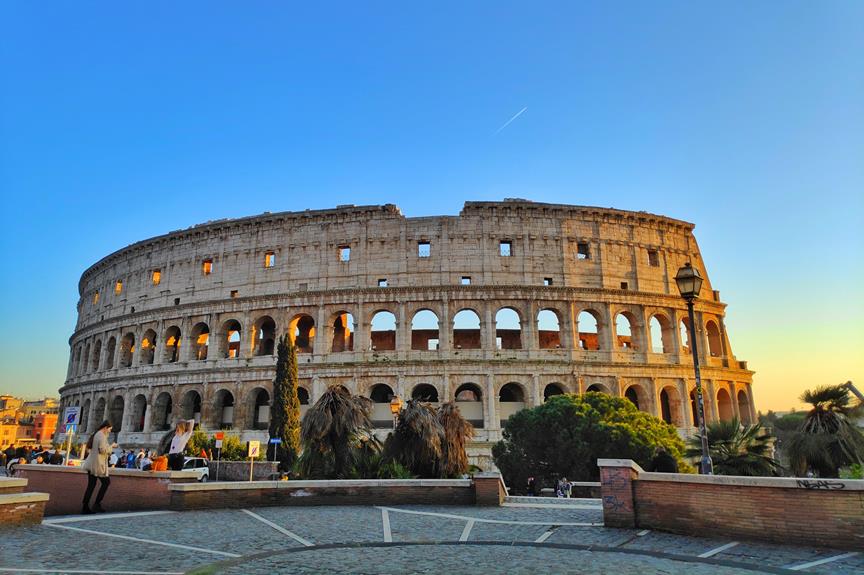As someone who appreciates serving others, I am excited to share with you the historical architectural wonders of Algarve.
One example of these wonders is the Arco da Vila Interpretative Center, which offers a captivating insight into the region's past.
But that's not all! Algarve is also home to Casa Do Povo do Concelho de Olhão, Convent de Sao Jose, Forte de Santo António, and São Bartolomeu de Messines Church, all of which showcase the rich history and cultural heritage of this beautiful region.
From stunning arches and castles to beautifully restored convents and churches, these landmarks provide a unique cultural experience for visitors.
Join me as we explore the historical treasures of Algarve!
Key Takeaways
- Arco da Vila Interpretative Center offers insights into the region's past and showcases the rich history and cultural heritage of Algarve.
- Casa Do Povo do Concelho de Olhão reflects the region's rich history and cultural heritage and offers a unique cultural experience for visitors.
- Convent de Sao Jose represents the region's cultural heritage and showcases the beauty of Portuguese religious architecture.
- Forte de Santo António reflects the region's rich history and cultural heritage and showcases the beauty of Portuguese fortress architecture.
Moorish Castle of Silves
The Moorish Castle of Silves, which is the largest and best-preserved ancient monument in the Algarve, stands as a testament to the region's rich history. This magnificent red sandstone castle is a true architectural wonder that transports visitors back in time. As I entered the castle, I was in awe of its imposing walls and towers, which are a striking display of Moorish craftsmanship.
The castle's strategic location offers breathtaking views of the surrounding landscape, adding to its allure. Walking through the castle's gardens, I couldn't help but marvel at the meticulous preservation efforts that have allowed this historical treasure to be enjoyed by visitors today.
Silves Castle isn't only a symbol of the region's past, but also a reminder of Portugal's cultural heritage. Transitioning into the subsequent section about the 'Church of São Lourenço', another historical architectural wonder in the Algarve, we can continue exploring the rich history and cultural significance of this beautiful region.
Church of São Lourenço
Transitioning from the Moorish Castle of Silves, another historical architectural wonder in the Algarve is the Church of São Lourenço. Also known as the Igreja da,de Santo, this small white church is located in the municipality of Loulé. The church's exterior may seem unassuming, but its interior is a true masterpiece.
As you step inside, you're greeted by a monumental space adorned with ceramic tiles and golden carvings. The walls, dating back to 1730, are covered with azulejos depicting biblical scenes and the life of St. Laurent. These vibrant tiles, made in Lisbon, add color and luminosity to the church.
The combination of azulejos, statues, gilding, and a magnificent carved chest creates a memorable and unique experience for visitors. The Church of São Lourenço attracts visitors from all over, who come to admire its beauty and historical significance.
Moving forward, let's explore the next historical architectural wonder in the Algarve, the Lagos Old Town Walls.
Lagos Old Town Walls
What makes the Lagos Old Town Walls in Algarve a historical architectural wonder?
The Lagos Old Town Walls, located in the heart of the Old City, are a testament to the rich history and architectural diversity of the region. These walls were built in the 16th century to protect the city from invasions and pirate attacks.
As I walked along the walls, I was amazed by their grandeur and the breathtaking views they offered of the city and the sea.
The walls are also home to the Convent de Nossa Senhora do Carmo and the Church of São Sebastião, both of which are recommended places to visit. The white church, known for its stunning architecture, adds to the charm of the Old City.
Exploring the Lagos Old Town Walls is a must for anyone seeking to delve into the historical heritage of the Algarve.
Tavira Castle
As I continued my exploration of Algarve's historical architectural wonders, one site that captivated me was Tavira Castle. This medieval fortress, located in southern Portugal, is truly a sight to behold.
Built in the 13th century, Tavira Castle stands as a testament to the region's rich history and is one of the best places to immerse oneself in the past. Stepping inside the castle's Romanesque gates, I was transported back in time. The castle's robust walls and defensive towers provided a fascinating glimpse into medieval defensive strategies.
As I explored further, I discovered a cistern and a charming garden, adding to the castle's allure. From the castle's elevated position, I was treated to breathtaking panoramic views of Tavira and the Gilão River.
Visiting Tavira Castle for the first time was a truly memorable experience, and I highly recommend it to anyone interested in historical architectural wonders.
Faro Cathedral
Continuing my exploration of Algarve's historical architectural wonders, I frequently found myself in awe of Faro Cathedral, a magnificent testament to the region's religious and artistic heritage. Situated in the heart of Faro's Old City, this grand cathedral stands as a symbol of resilience, having survived the devastating 1755 earthquake. The cathedral's exterior is a stunning sight, with its white façade and intricate blue and white azulejo tiles that depict biblical scenes. Stepping inside, visitors are greeted by a lavish baroque interior, adorned with ornate gold accents and exquisite artwork. Aside from its architectural beauty, Faro Cathedral also offers a panoramic view over the city and the breathtaking Ria Formosa Natural Park. As I stood on its rooftop terrace, I couldn't help but marvel at the historical and cultural significance of this remarkable structure, which proudly represents Algarve's rich heritage as Portugal's southwestern-most point.
| Facts About Faro Cathedral | |
|---|---|
| Location | Faro's Old City |
| Style | Baroque |
| Features | Azulejo tiles, gold accents |
| Historical Significance | Survived the 1755 earthquake |
| Special Attractions | Panoramic view of Faro and Ria Formosa Natural Park |



